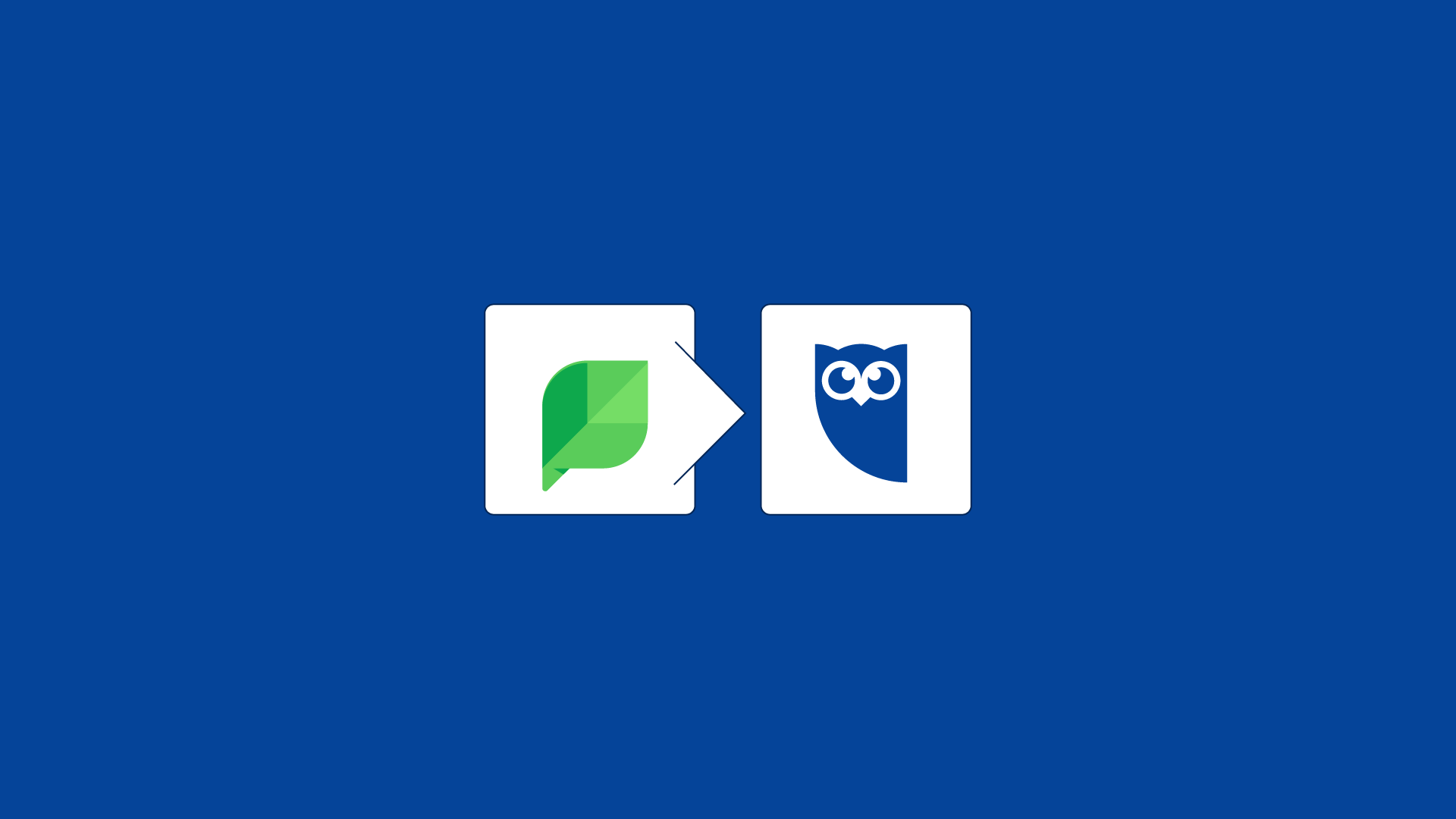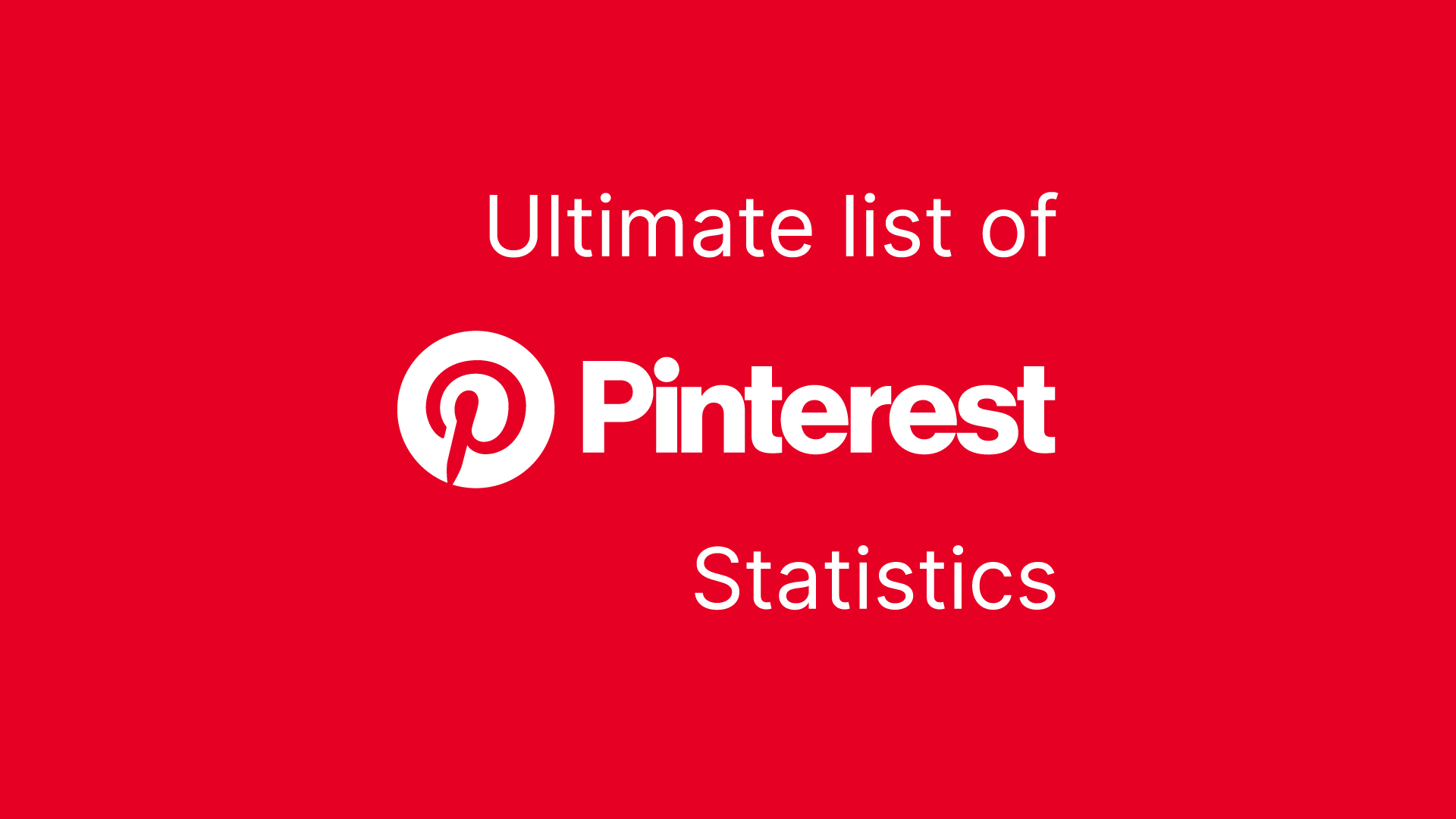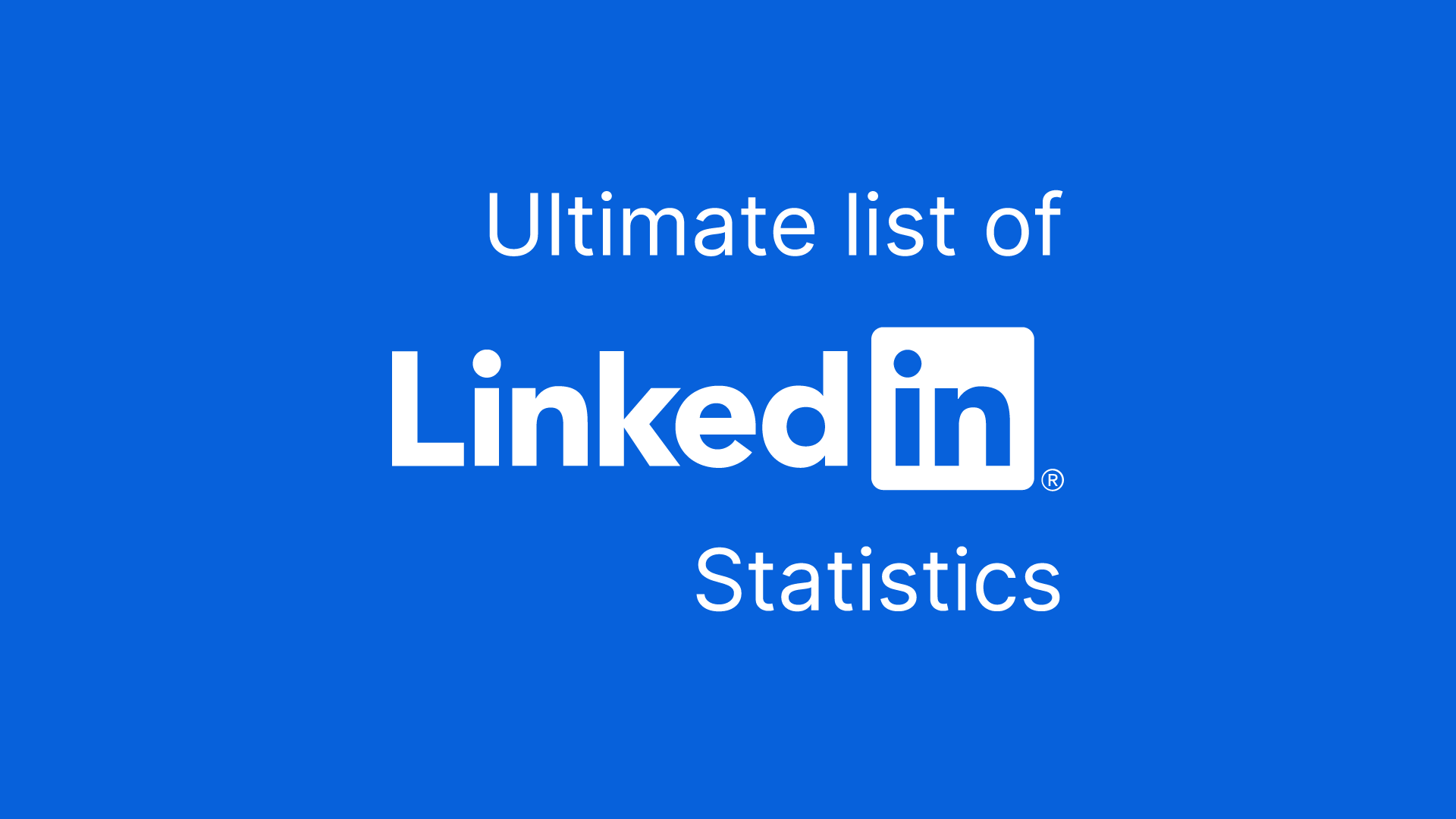You know that social media marketing can be a powerful tool for your business. But you want to know how to make it work best for you.
You’re in the right place. We’ve put together this guide to help you get the most out of your social media marketing efforts.
Social media has become an integral part of many businesses marketing strategies. In fact, according to research from Social Media Examiner, 97% of marketers use social media in their marketing efforts.
But what do they use it for? And how can you make sure that your social media marketing is as effective as possible?
In this social media marketing guide, we’ll cover everything from creating a strategy to measuring success and understanding your audience’s preferences.
We’ll also provide some helpful examples of brands that are succeeding on social media right now. Also, we will look at some tips on how they’re doing it and winning.
Social media marketing, sometimes called social media advertising, covers several ways that brands can use social platforms like Facebook, Twitter, and Instagram to build their business.
It ranges from paid ads targeted at users to sharing organic valuable content with your audience. Social media is an incredibly accessible way for businesses to connect with their customers.
Social media marketing is all about leveraging social media platforms as a tool for building your brand awareness. Additionally, increasing conversions on other channels like Search Engine Optimization or email marketing.
It takes a lot to succeed in social media marketing, and we will look at that in detail later.
Though it’s one of the most valuable ways you can grow your business, you need to create a different strategy for each platform. This can seem like a big task, but it’s worth it. Not all social media platforms produce results the same way for the same approach and content.
Let’s take a look at how social media works.
What is Social Media Marketing?
Social media marketing is a type of digital marketing that leverages social media platforms to promote a brand, product, or service.
It involves creating and sharing content on platforms like Facebook, Twitter, Instagram, LinkedIn, and others to engage with your target audience, build brand awareness, and drive traffic to your website.
By connecting with customers in real-time, businesses can foster relationships and create a loyal community around their brand.
The power of social media marketing lies in its ability to reach a vast audience quickly and efficiently. Whether you’re sharing a blog post, a product update, or a behind-the-scenes look at your company, social media allows you to communicate directly with your audience.
This direct interaction helps build trust and credibility, making it easier to convert followers into customers.
How Does Social Media Marketing Work?
The goal of social media marketing is to attract new customers by increasing brand awareness and engagement. To do this, you need to create content that will resonate with your audience. Then promote it across different platforms like Facebook, Twitter, LinkedIn, Instagram, and YouTube.
A social media marketing plan is essential as it acts as a roadmap for measuring success and optimizing resource utilization, while also gathering valuable customer data for informed market analysis.

The more people who engage with your content, the more exposure you’ll get from other users who follow those accounts.
Because of all this activity, people will begin searching online for information about your company or product.
One of the ways you get a performing social media page is through the use of Social Media Optimization strategies. These strategies use SEO principles applied specifically for each social media platform.
With these principles, you can achieve visibility in search results based on keywords relevant to your audience.
Social media marketing is a key component of any successful online marketing strategy. Social media has become such a popular way for brands to connect with their customers. This is because it has the ability to market directly to potential customers.
Take note, that social media marketing doesn’t come without its challenges.
There are so many platforms out there, and each one has its own unique characteristics and functions. This makes it difficult for businesses to know where to start.
They might be tempted to just hop on every single platform and hope for the best, but this would be a huge mistake.
Instead, you should focus on developing a strategy that will give you the greatest ROI. Also, allowing you to make an impact on your target audience.
Check out the most popular social media platforms.

You need to get yourself a profile on each social media site that you think will be most useful for your brand. These days, there are so many different platforms that it can be hard to decide where to start.
Here are some of the top social media platforms you can use to promote your business;

Twitter is another top pick because it allows users to broadcast short updates (called “tweets”) about their thoughts. And it’s easy for others to retweet those tweets for them to spread even further.
A great way to get started on Twitter is by following people who share interests like yours. You can also engage with them through retweets or replies.
Twitter focuses on giving users the ability to create and share content with others in only 140 characters or less.
It’s a great way to reach out to people who have similar interests as you do since it allows you to share links and photos in short bursts of time.
Twitter is great for user-generated content, short-form, and creative video content.
Tiktok
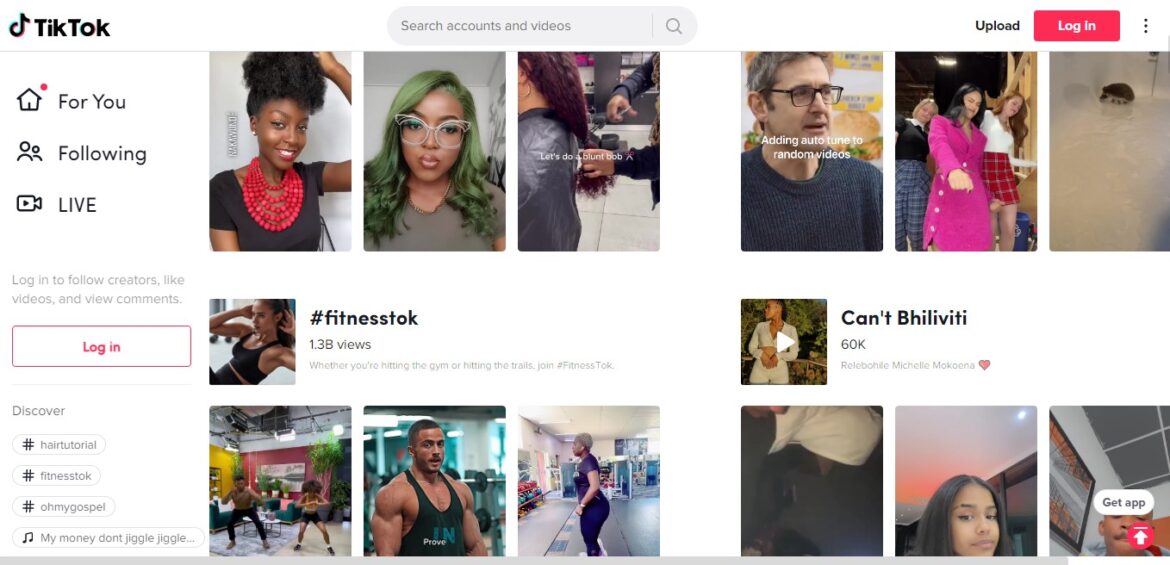
Tiktok is an online video platform used by over millions of people every day to share videos through short clips called “Stories.”
Many celebrities use Tiktok to post behind-the-scenes footage from events or even just funny moments from their day! You can also use it to watch music videos and other types of content on this app too!
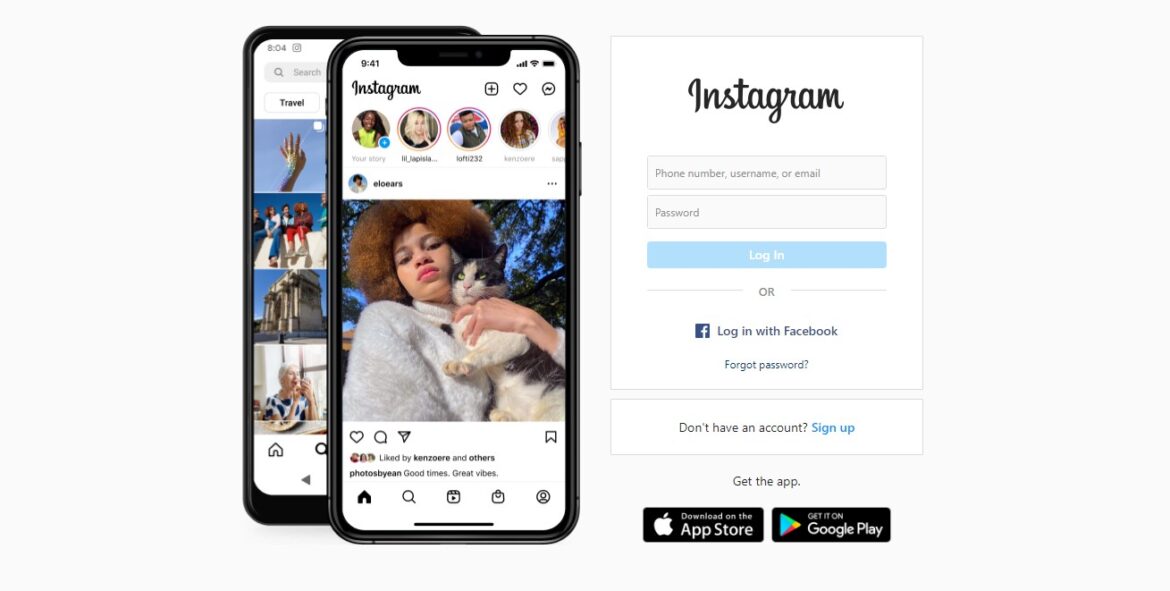
Instagram is a social media platform that has over 1 million active users. It’s also owned by Facebook. This platform allows you to create visual content that can you can share with friends, family, and more.
Instagram is popular because it allows its users to create beautiful content and connect with people around them through hashtags.
If your target audience is between the ages of 18 and 35, Instagram is one of the best places to find them. It’s also perfect for showing off your company’s products and services in an aesthetically pleasing way.
Snapchat
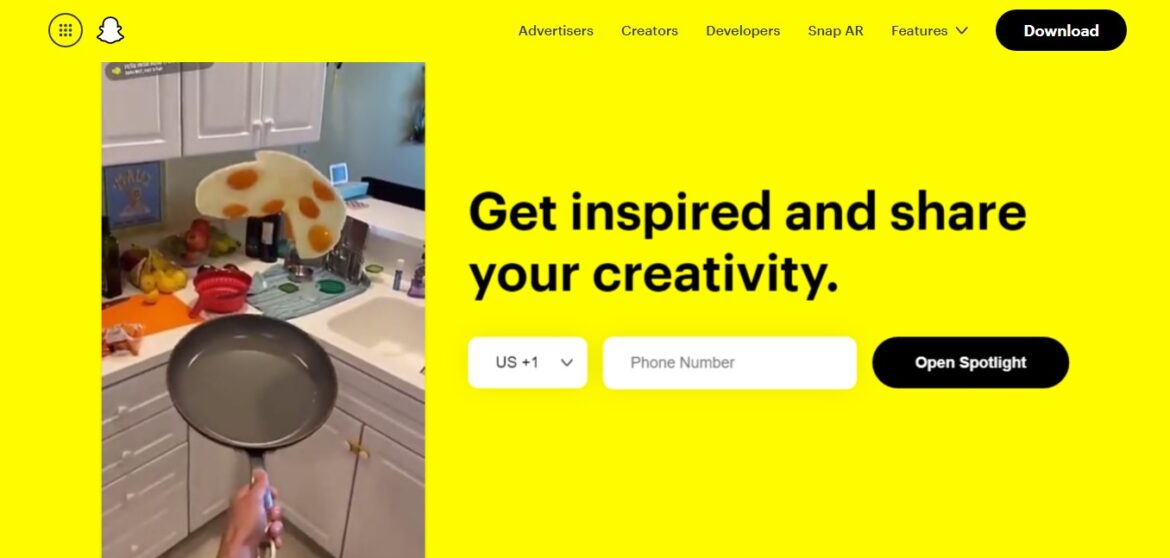
Snapchat is another application that lets users send pictures and videos through an app called “snaps”. These snaps can be viewed once by recipients. They are then deleted after 24 hours so they’re not saved forever as other apps such as Instagram or Facebook might do.
Instagram is still holding strong as the most popular platform in terms of user numbers, but Snapchat is gaining on them quickly. It’s got many of the same features as Instagram but with a more personal feel.
With Snapchat, you can send short videos and photos to contacts that disappear after they’re viewed. This has made it particularly popular among teens and young adults.
Linked In

LinkedIn is an online professional networking service that has over 800 million users worldwide. LinkedIn allows you to connect with other professionals who share similar interests or goals. As you do so, they can share knowledge and experience with you and help each other out professionally.
Linkedin is great for professional networking and building relationships with other professionals in your industry.
Businesses and job-seekers also turn to LinkedIn to look for new employees. It allows employers to post job openings without revealing their names or company details.
In addition, LinkedIn has several features aimed at helping users build their professional portfolios. By posting articles on their profile, they can then share them publicly or privately with others who may want to read them.
Benefits of Social Media Marketing
Although the goals may vary depending on your particular business needs, there are several general benefits associated with social media marketing. When properly executed, social media marketing can do all these things and more.
As more and more consumers move away from traditional forms of advertising to online, the importance of effective social media marketing continues to grow.

Social media marketing campaigns play a crucial role in driving consumer decisions through measurable interactions and electronic word-of-mouth (eWOM) recommendations. Businesses should track their performance and adapt strategies based on data-driven insights to gauge the success of these campaigns.
Social media has become a critical aspect of business branding strategies. This is because it’s an effective way for businesses to convey their value proposition. As they do this, they create opportunities to communicate with their target markets.
One of the best ways to advertise is to write articles. Also, with this type of advertising, businesses can build trust and establish themselves as thought leaders within their fields. You can do this by simply interacting directly with potential clients regularly.
Social networking sites are especially useful tools for B2B marketers who want access to large numbers of relatively well-educated prospects. They already know what the company does or at least what industry they’re working in.
Ultimately, this method allows companies to showcase relevant product offerings without coming across as blatant sales.
Social Media Marketing Increases Brand Awareness

But this growth is not without its drawbacks. I’m sure you’ve heard the question, “Are you on Facebook?” more times than you can count.
But as social media has grown, it’s also become less of a novelty and more of a necessity to have an online profile. That includes businesses.
And while social media marketing might seem daunting at first, there are tons of ways brands can use social media to get their name out there and reach new customers.
The keys to success are creating compelling content, posting it at the right time, and using the right tools for analytics. In fact, there is proof that social media usage can increase brand awareness and increase engagement with your brand.
Social media can also increase brand awareness by driving traffic to your website. It is one of the best ways to promote your website content and reach more people who would not otherwise find you through search engines.
It Generates Leads and Boosts Conversions
Let’s start with a basic question, what do you want to accomplish on social media? If your goal is to generate leads, then you need to set up a lead generation strategy using social media.
If your goal is to boost conversions, then you’ll need to be strategic about how and when you post and employ tactics that directly promote sales. These are the basics of social media marketing.
Social media platforms like Facebook can give you an advantage over your competitors by letting you connect quickly and easily with potential customers.
Here’s an example of how to use Facebook for lead generation:
Example: How you can use Facebook for Lead Generation if you are a fitness brand
Find potential customers who’ve posted publicly about their problems using hashtags. After identifying these people, send them messages asking if they want help.
You can also use groups designed for people interested in health, fitness, or wellness (#fitnessenthusiasts) as a way of finding leads who might want what you’re offering.
Create custom audiences based on the information they’ve shared with others to target these individuals more efficiently when posting ads or sponsored content. Benefit from more targeted ad delivery by narrowing your targeting options based on their interests and major life events. (e.g., having kids).
Consider using a retargeting campaign to stay top-of-mind throughout the sales cycle for people who’ve visited your website but haven’t converted yet. (retargeting requires using Facebook pixels).
Offer discounts or giveaways that are exclusive only to those who’ve signed up for emails and other communications from your company. This will encourage them to sign up while giving everyone else something extra as an added incentive.
Sell your products using the Facebook shop section or Instagram shopping feature. You can use eCommerce platforms like Ecwid to build your online store and sell on Facebook to your audience.
Build relationships with customers
Social media gives you the chance to reach a large number of people, and build relationships with customers. One way to do this is by being where they are, when they ask questions related to your niche, be there to answer and provide value.
Interact with your followers on your posts, and respond to questions they have and their comments. The more engaged your audience is the more you will get them closer to your brand.
To take it even further, ask them questions about your product, and run surveys on what pain points they address.
When you do this for your audience they will trust you and always come to you for help. This is because they will feel valued and want to support your brand even more.
You can Learn From Your Competition
As in any marketing strategy, competitor research is important. Social media platforms like Facebook can share data with you about how your competitors are doing on their platforms.
This way you get more insight into the strategies they are implementing and how you can improve yours.
How to Use Social Media Marketing to Build Your Brand
When you want to expand your reach to more diverse audiences, social media is one way to go.
Social media marketing includes many techniques, from creating accounts on different sites to posting content. Also, commenting on other people’s posts, creating hashtags for your brand, and more.
Here are some ways you can use social media marketing to build your brand:
Gain a larger following. If you post regularly (ideally once or twice per day) and garner the attention of influencers in your industry, you can attract followers who might like what you have to say or buy your products or services. This will help bring in new customers for your business.
Get feedback about your product. Engage with users who comment on your posts by replying to them directly. This way, you’ll be able to understand how they feel about what you’re doing and adjust accordingly.
Connect with potential customers. Conduct polls and surveys using tools like SurveyMonkey to collect data from your followers about things they want from the company’s product line or services. This information can help guide future decisions about how best to cater products towards what consumers want and how best to communicate these changes through social media channels.
Increase brand awareness. Share interesting content such as behind-the-scenes videos regarding different aspects of life at your company or pictures of employees having fun at work events throughout the year so that people come away learning more about who you are as a company rather than just seeing advertisements for products.

How to Create a Social Media Marketing Strategy
Start by setting goals.
Research your buyer persona.
Determine which social media platforms you will use. Social media marketing platforms are essential tools for businesses to enhance their online presence and engagement.
Establish your most important metrics.
Get to know your competitors.
Create unique and engaging content.
Organize a posting schedule for your content.
1. Start by setting your Goals
To create a social media strategy that brings results, it’s important to keep in mind your long-term goals and the steps you can take right now to achieve them.
What are your long-term goals?
Short term: 3 months
Medium-term: 6 months
Long term: 12 months
The key to identifying these goals is thinking of what will make you happy. You’re going through this process because you want something out of it. Be honest with yourself about what that is, and don’t be afraid of setting a bar high enough to challenge you.
It’s better to be ambitious than to underestimate where your efforts can take you. The more specific and measurable the goal, the more likely it will be achieved.
If you’ve been running for six months but haven’t kept track of your distance or times, then how do you know if that’s good progress?
How about being able to run four miles instead of three? Or shaving off three minutes from your mile time?
Having concrete achievements makes goals much easier—and more rewarding! In some ways, crafting achievable goals is harder than having lofty ones.
Don’t forget the importance of taking things one step at a time while also pushing yourself toward bigger things by setting interim benchmarks along the way.
2. Research your buyer personas and audience
By investing time into finding out about your customers and what they like, you’ll be in a better position to reach them with your marketing efforts.
Use social media to find out what people are saying about your products and service, but also use it to get to know your customers by interacting with them.
You can go further by surveying or talking with customers directly. Online demographics tools can give you information on age, location, income level, education level, marital status, and many other factors relating to the audience of potential customers you’re trying to reach.
Once you’ve researched your buyer personas and their interests, you must build a social media presence tailored specifically to the needs of the audience you want to reach.
This means creating separate accounts for each type of social media network that your target consumer uses instead of simply having one generic account. (e.g. @yourcompanyname).
3. Determine which social platforms you’ll market on
Before you begin marketing online, you need to know where to focus your efforts. If you try to do everything at once, you’ll spread your attention too thin and accomplish nothing at all.

First, figure out which platforms your target audience uses. It’s useless to market on the same social media site as a competitor if the majority of their customers are on a different one.
Next, check out what the competition is doing. What’s working? What’s not? Keep in mind that others may be using tricks that don’t apply to your brand or customer base.
Resources, time, money, and staff—are limited, so choose wisely where you focus them and avoid wasting time or money on sites or channels where it won’t make much of a difference anyway.
Once you decide where most of your marketing efforts will go, keep in mind that it takes time for any channel to build up its audience and get traction with new users. Consider starting with just one platform until you see results there before adding more channels into your mix.
4. Establish your most important metrics and KPIs
Social media marketing is a crucial part of any modern marketing strategy, but it’s also an extremely broad field with a lot of new terminology and metrics.
This can make the process seem overwhelming, especially if you’re not sure what to focus on or how to figure out which business goals to achieve.
Here’s a breakdown of the most important metrics and KPIs for social media marketing, as well as some examples of tools you can use to measure them and some suggestions for how to improve business performance with them.
5. Get to know your competition
First things first, let’s find out how much natural competition there is in your market.
To get to know your competitors you first have to identify them and run a competitor analysis on them. When you do this, you will understand This will give you a good sense of what is happening in your industry. When you know what goes on, you get to identify opportunities when they arise.
If your competitor is active on Instagram for example, you might want to focus your efforts on youtube for example to reach your audience where your competitor is not. All that effort will translate to more visitors, subscribers, and website traffic.
6. Create unique and engaging content
Social media is a powerful tool to help you connect with your audience and engage in conversations that matter. But like any marketing channel, it takes time and effort to be successful.
In this section of the guide, we’ll show you how to build an engaged community on social media, from the ground up. We’ll show you how to find and cultivate new audiences for your blog or website by sharing stories about real people with similar interests as you do in-person networking.
We’ll talk about ways to grow communities through creative content, such as Snapchat Stories or interactive polls and surveys.
7. Organize a posting schedule for your content
To help maintain a steady stream of content, it’s helpful to create a social media posting schedule and stick to it.
It’s always important to know exactly when you’re going to post. This is especially true with images and videos, which can take longer than text posts to upload. This is something that apps like Sprout Social, Hubspot, and Hootsuite make easy.
If you change the time or date for any of your scheduled posts, all of them will shift accordingly on all the platforms you’ve selected. To keep things interesting and varied, try scheduling a mix of different types of updates.
Mix in what you’re reading, what your friends are up to, exciting events happening in your life that might be worth mentioning (or not), etc., and use a tool like Sprout Social or Buffer to drop mentions of these things into your scheduler.
With so many posts being created at once, most people will inevitably find some duplication among their networks after filling their days with blog entries/tweets/Instagrams/pics about their dog eating some toast.
To avoid this (and help cut down on the amount of time spent posting), many people choose to set aside one day each week where they focus exclusively on sharing original content from other sources they enjoy.
Developing a Social Media Content Strategy
Creating a robust social media content strategy is essential for the success of your social media marketing efforts. A well-thought-out strategy involves planning the type of content you will create, determining the frequency of your posts, and selecting the appropriate social media channels to use.
Start by identifying your target audience and understanding their preferences and behaviors. What type of content do they engage with the most? Are they more likely to respond to educational posts, promotional offers, or engaging stories? By answering these questions, you can tailor your content to meet their needs and interests.
A balanced social media content strategy should include a mix of promotional, educational, and engaging content. Promotional content can highlight your products or services, educational content can provide valuable information and tips, and engaging content can include interactive posts like polls, quizzes, or user-generated content. This variety keeps your audience interested and encourages them to interact with your brand.
Social Media Marketing Best Practices
There are plenty of best practices for social media—here are just a few:
Create an editorial calendar that lists social posts for each month out into the future. This takes some time upfront but will save you so much time in the long run. There are many different social media tools you can use to plan out your posts in advance.
My personal favorite is CoSchedule since it allows me to plan my entire month at once on one calendar view or create multiple calendars based on different topics or ideas I’m working on at any given time.
Use analytics tools such as SEMRush to measure your success with each post so far including your total reach, impressions per post, etc… This way you can continue posting similar content that works well for your audience.
Use hashtags to add context to your content if applicable.
Engage with customers by replying to comments or messages promptly.
Research buyer personas of potential customers so you can better target them in future campaigns.
Build relationships with influencers who have large audiences.
Finally, Don’t be afraid of failure. You’ll have plenty as you learn what works best for your business/brand.
How to Analyze your Social Media Marketing Results
If you’re using social media for your business, you should be measuring your results. This is a great way to see what’s working, what’s not, and how you can improve. Utilizing a social media analytics tool is crucial for effectively measuring and tracking the success of your social media strategies. Here are some metrics you should be tracking:
Engagement: Are people liking, commenting on, sharing, or responding to posts? The more engagement you see, the better.
Reach: How many people were exposed to each piece of content? This includes people who saw it in their feed as well as people who saw it in search results.
Followers are the number of people who follow your account on that particular platform. The higher the number of followers, the more likely it is that they’ll see your content when it goes live on that platform.
Impressions: How many people have seen your profile in the last month? This can be done by looking at the number of times people have visited or viewed your profile.
Video views: How many people have watched videos on your channel? You can use this to see what kinds of videos perform well and adjust accordingly.
Profile visits/views: How many people visit or view your profile every month? This is useful for measuring engagement as well as growth over time.
Mentions: How many times have other accounts mentioned yours in their posts? This is a good indication that others consider you relevant to their audience and worth mentioning in posts themselves.
Reposts: How many times has someone reposted one of your social media posts. One example of this metric is retweeting.
You can use analytics tools like Twitter Analytics, Facebook Analytics, and Instagram Insights to measure these metrics. You can also use third-party free tools like Hootsuite or Buffer for this purpose.
Lastly, many social media management tools have monitoring and tracking features automatically built-in.
Optimizing Your Social Media Marketing Efforts
To maximize the impact of your social media marketing efforts, it’s crucial to continuously optimize your strategies. Start by using social media analytics tools to track the performance of your posts and campaigns.
These tools can provide insights into which types of content are resonating with your audience, the best times to post, and how your engagement rates compare to industry benchmarks.
Social media management software can also play a significant role in optimizing your efforts. These tools allow you to schedule and publish posts across multiple platforms, engage with your followers, and monitor conversations about your brand.
By automating these tasks, you can save time and ensure a consistent presence on social media.
Additionally, consider using paid social media advertising to reach a larger audience and increase brand awareness. Paid ads can be highly targeted, allowing you to reach specific demographics, interests, and behaviors.
This targeted approach can help you attract new followers, drive traffic to your website, and ultimately increase conversions.
By continuously analyzing your performance and adjusting your strategies, you can ensure that your social media marketing efforts are as effective as possible.
Social Media Marketing Tools
Social media management tools help you save time by automating certain tasks, keeping you organized, and providing insight into your social media performance. They are essential to running a successful social media marketing campaign.
What’s the best way to find the right tools for you? There’s a lot of information out there on these tools, but we have a list of the best social media tools you can explore.
Here are a few that stand out for us.
Sprout Social
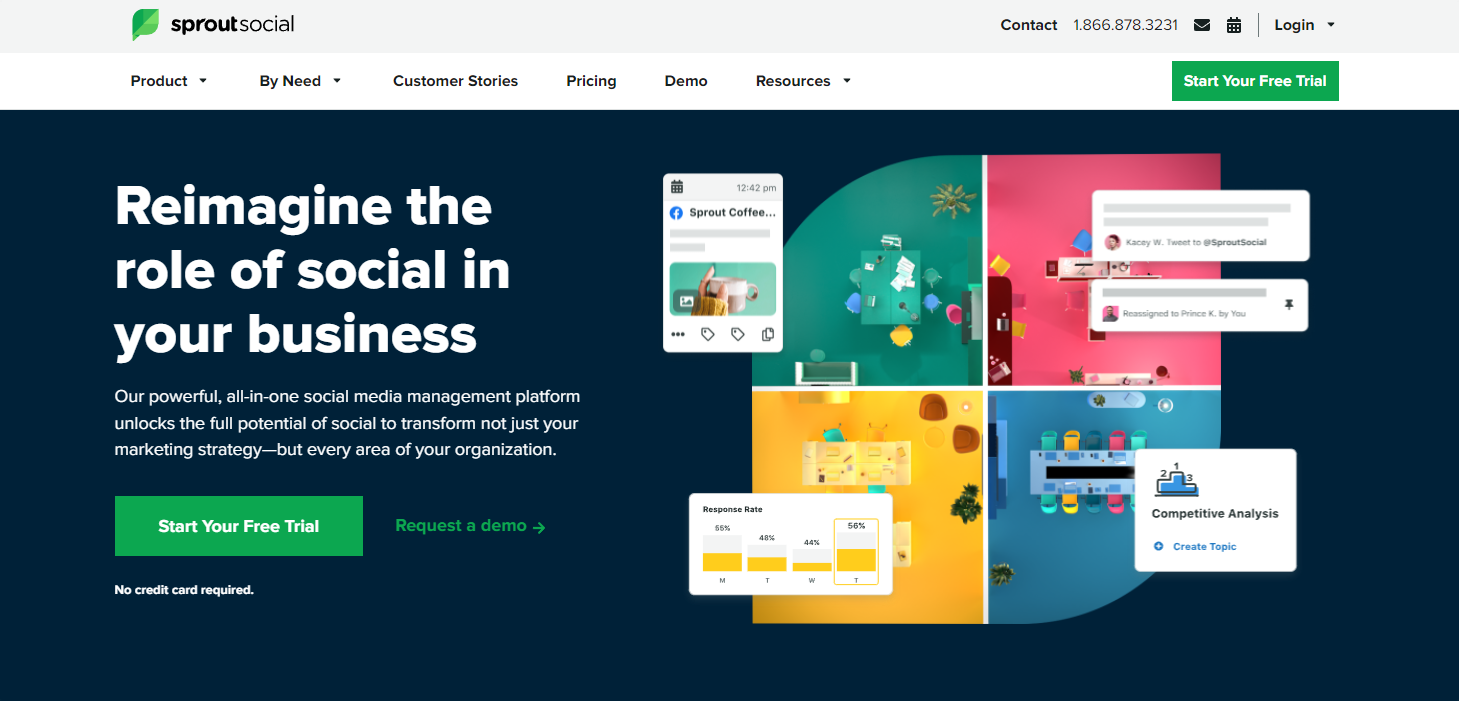
Sprout Social is social media management software that helps you manage every post, engagement, and opportunity across your various accounts.
With Sprout Social, you can connect with your audience, strengthen relationships, and better understand how specific posts are affecting your brand.
Check out our sprout social review.
Hubspot
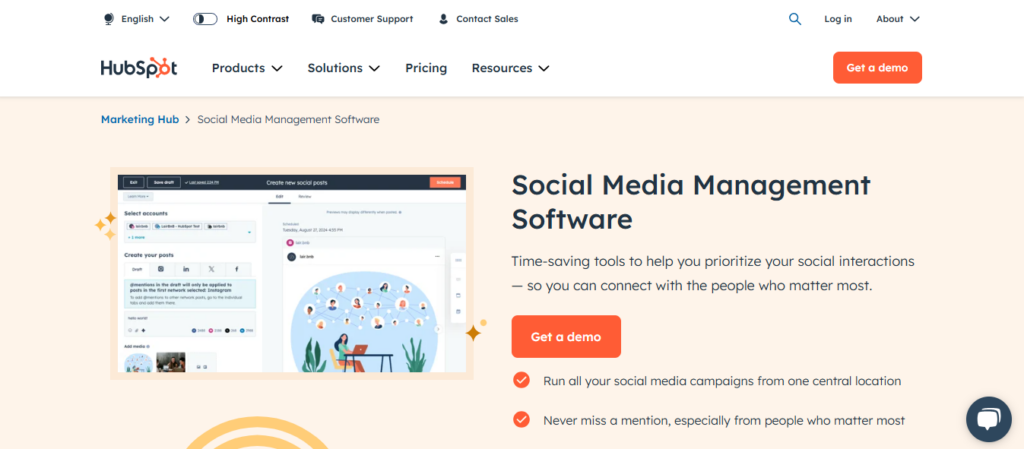
HubSpot’s social media management software allows you to create and publish social media campaigns with ease.
Because it’s a full suite of marketing software, there are great integrations like Canva to bring you the Canva experience right into the HubSpot platform.
You can design ads, banners, and social graphics, and publish them to different marketing channels.
Buffer
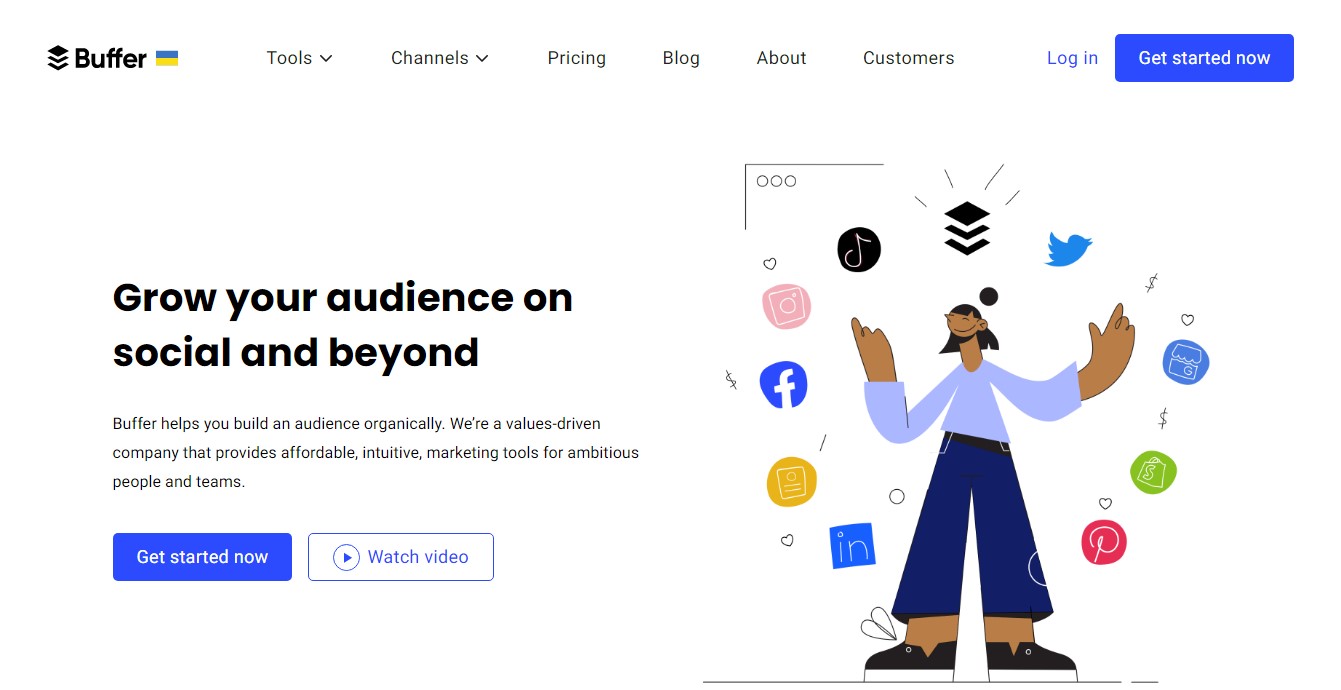
For years, marketers have used the Buffer publishing platform to schedule posts to different platforms. Buffer has divided its business into three categories: Publish, Reply, and Analyze.
A feature of Buffer has recently been introduced allowing you to include the first comment with your scheduled Instagram posts. Third-party tools offer most of the advanced features that Buffer offers.
Hootsuite
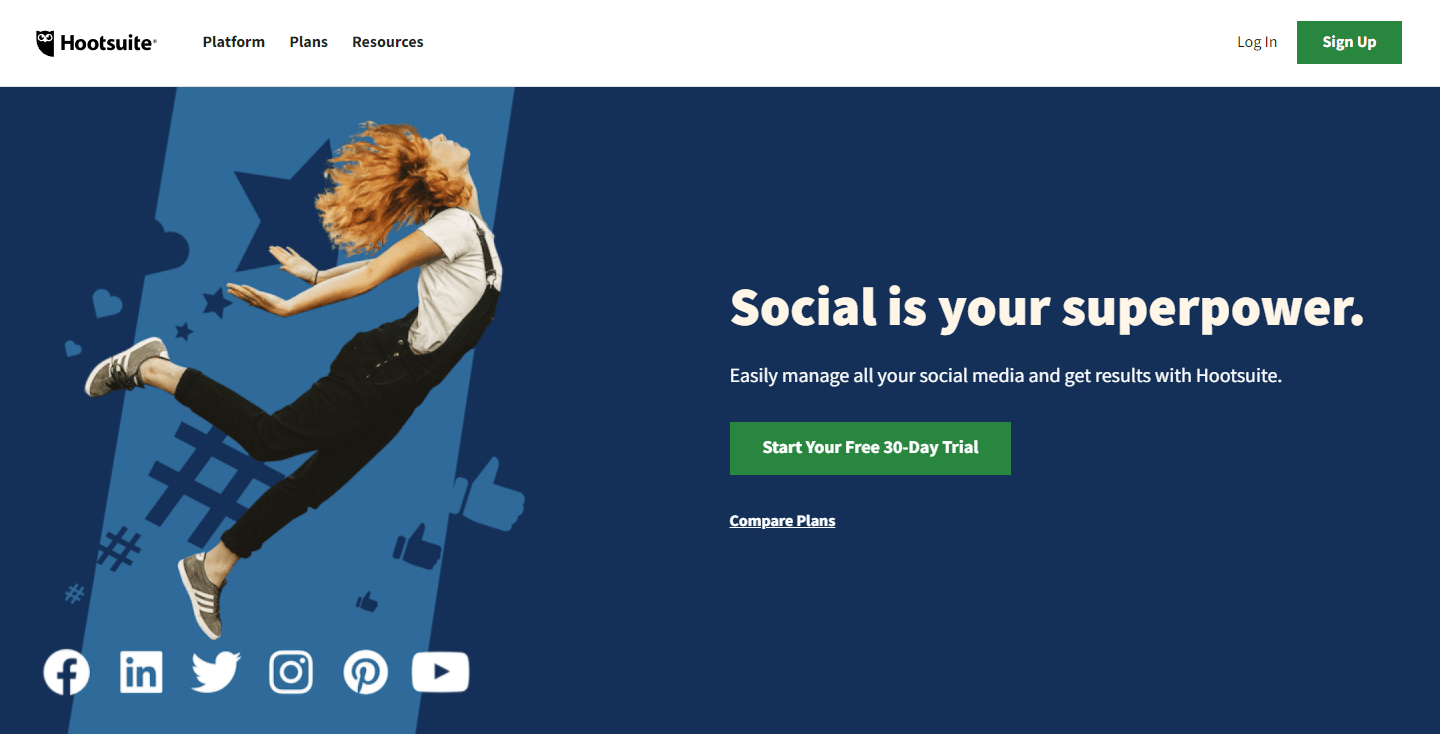
Hootsuite allows businesses to track their clients and understand how they feel about the brand.
It’s important to break down any preconceived notions the client may have regarding your brand. Hootsuite has a clean, easy-to-learn user interface that provides a lot of valuable features.
Social Pilot
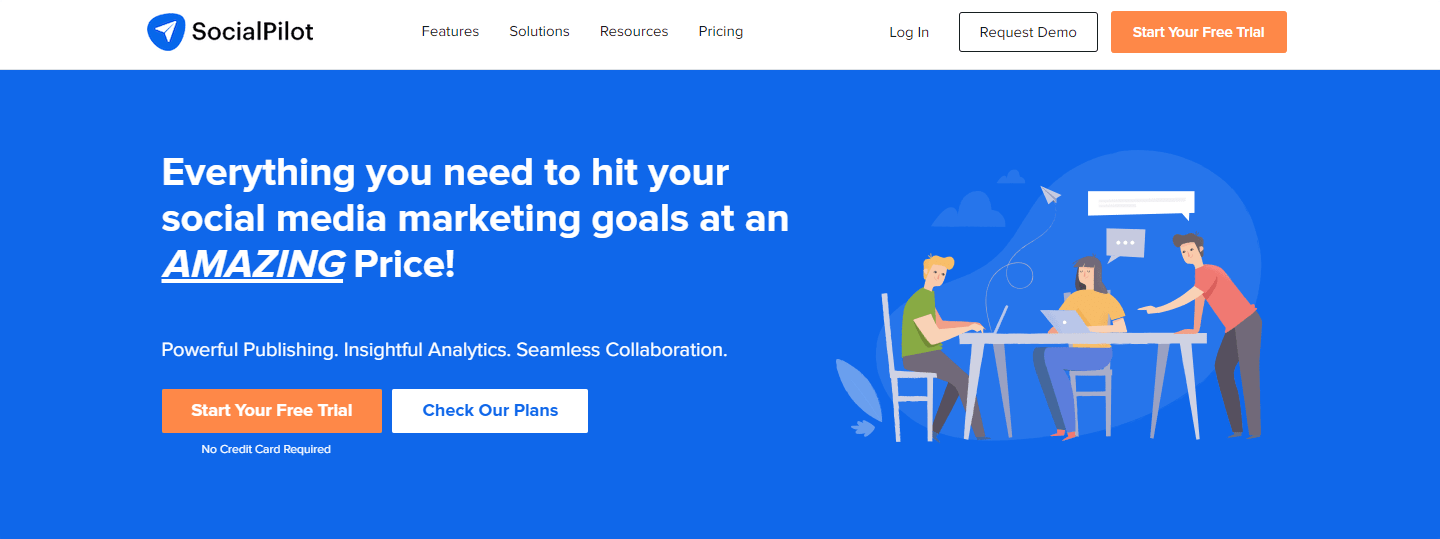
SocialPilot lets you manage multiple social media accounts, schedule your posts, and engage with your audience all in one place.
SocialPilot helps you plan, create, schedule, and publish your posts using advanced features.
Social Media Marketing Courses
Social media is one of the most influential marketing tools in the world today. If you want to stay competitive, you must understand how social media works and how to use it effectively.
Here are a few of the best social media courses available today.
Social Media Certification by HubSpot
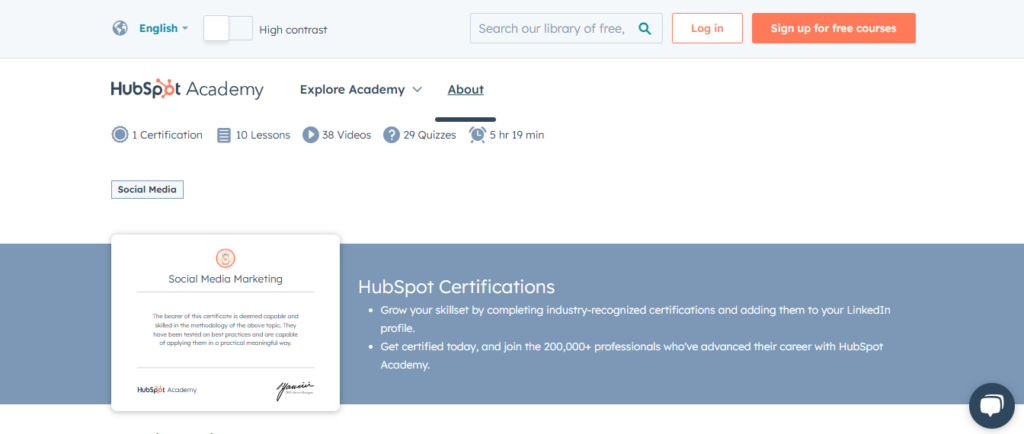
Hubspot’s Social Media Certification provides an in-depth look into building a social media strategy, topics such as measuring ROI, extending reach, social media content creation, and social listening. The course also covers setting social goals, structuring your social media team, creating a content strategy, and influencer marketing.
Social Ads 101 by Wordstream
This course offers the necessary educational resources to develop a strong understanding of social media advertisements. This includes social media ads on a variety of platforms such as Instagram, Facebook, YouTube, Snapchat, Tik Tok, and LinkedIn.
Fundamentals of Digital Marketing from Google Digital Garage
Google’s Social Media Certification has over 300k students and provides courses in
Social Media Marketing Strategies
Mobile Advertising
Search Engine Optimization (SEO) Fundamentals
Web Analytics Fundamentals
Advanced Search Engine Optimization (SEO).
The courses explain paid and organic search and teach you how to develop search-engine-optimized web pages. It also covers advanced concepts like pay-per-click advertising (PPC).
Start your Social Media Marketing Campaign
Social media marketing is a way of interacting with people and businesses on various platforms to get them to like, share, or buy your stuff.
It can be done by sharing pictures of your lunch, hosting a tweet chat, or blogging about the latest must-have products.
The most well-known social media platforms include Facebook, Twitter, Instagram, LinkedIn, Pinterest, Snapchat, Reddit, and Tumblr. Choosing which ones to focus on depends on what kind of business you are running.
If you’re trying to sell winter clothes then you’ll want Instagram and Pinterest. If you’re trying to sell video games then check out Twitter and YouTube.
When creating content for these networks it’s important to think about who your audience is. Chances are if you know your audience, you will post what is interesting to them that they will be interested in what you have to say.
That said there isn’t just one correct way of doing social media marketing. The best advice is just to play around with different ideas until something clicks.





